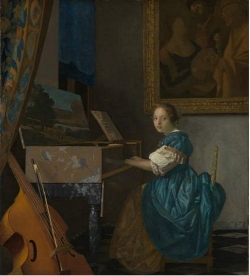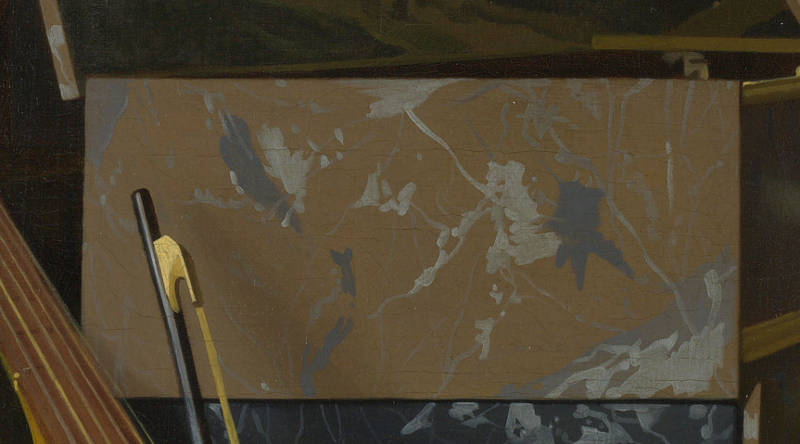Brushwork

Johannes Vermeer
c. 1670–1675
Oil on canvas, 51.5 x 45.5 cm.
National Gallery, London
For beginners in painting, brushwork might initially seem like a secondary concern. The primary focus often lies in identifying colors, mixing them accurately, and placing them correctly on the canvas. Brushwork, instead, involves a synthesis of the artist's materials, their movements (arm, wrist, fingers), and the pressure, speed, and angle of the brush. Each brush and paint type responds differently to various surfaces. Ideally, no two brushstrokes in a painting should be identical, and the artist must learn to make diverse marks convincingly, overcoming anatomical constraints. Fresh, precisely placed brushstrokes add character and authority to a painting, whereas amateur work often appears monotonous and overworked, lacking distinct character. With years of practice, an artist's movements become more automatic and confident.
Early modern art writers have suggested that the style of a painter evolves cyclically, with three distinct phases: initial learning from a master, development of a personal style reflecting their talent and genius, and a final stage often seen as 'mannered' due to reliance on habit rather than continuous study of nature. This concept was first systematically discussed by Roger de Piles in 1699.
In the case of Vermeer, his paint handling evolved in four distinct directions throughout his career, contrary to the perception of limited experimental brushwork in his art. By the late 1660s and particularly in the 1670s, Vermeer's brushwork became more visible and inventive.
Vermeer's early works such as The Milkmaid and Officer and Laughing Girl are marked by dazzling painting techniques. However, as his style evolved, his brushwork beceme more restrained. He applied paint in smooth, semi-opaque layers, reflecting the themes of the haute bourgeoisie, along with the porcelain, fine satins, and lacquered furniture that characterize these themes. His brushwork became subtle and unobtrusive, with minimal textural effects, suggesting form rather than detailing it. For instance, in Woman in Blue Reading a Letter, the brushwork is so fine that it's invisible. Similarly, in Mistress and Maid, the mistress's eye is rendered with just a smudge of grayish paint, conveying both flesh and thought. Vermeer may have used a badger brush for these effects.
Even though Vermeer's late works have been judged somewhat negatively in respect to his earlier paintings, these works feature some of the most exquisite examples of brushwork of his oeuvre. The artist's extraordinary power of pictorial invention and level of technical proficiency can be clearly seen in the rendering of the illuminated side of the marbled virginal of the late A Lady Standing at a Virginal. This flat, unassuming slab of marble appears so convincing that it is surprising to note the absolute economy of means by which it has been achieved.
Vermeer first laid down adjacent rectangles of smooth, virtually unmodulated paint, warm brown above, and a dark gray below. Once dry, Vermeer mixed two fluid grays, one lighter and the other darker, and applied them over the dry background tones with quick, jagged brushstrokes in order to imitate the marble veining. The brush handling is so daring and yet suggestive that it recalls the anarchic spontaneity of Ito Jakuchu's ink drawings of birds and vegetables, but at the same time, miraculously evokes the visual impression of veined marble. One author has compared this passage to Jackson Pollock's drip paintings.
To effectively depict the pale, diagonal shadow projected by the viola's bow onto the virginal's flat surface, Vermeer skillfully prepared a medium gray, transparent tone. He applied this tone thinly over the marble, ensuring that the underlying paint's color subtly showed through. It's probable that Vermeer employed a badger brush, a tool known for its softness, to gently blend the gray shadow. This technique helped to eliminate any visible brushstrokes, preserving the shadow's immaterial transparency. As a result, the shadow vividly connects the bow of the viola with the marbled surface, subtly revealing the light source that illuminates the entire scene. This interplay not only enhances the realism but also enriches the viewer's understanding of the spatial dynamics in Vermeer's composition.
